 Dean Motter has been intricately involved in the style of comic books for decades. While he is best known for Mister X, the series that launched several famous artists, he also created the acclaimed Terminal City and Electropolis series, and helmed many aspects of artistic direction at DC Comics for several years. Dark Horse was proud to release the stunning Mister X Archives in 2008, featuring over three hundred pages of beautiful, remastered work.
Dean Motter has been intricately involved in the style of comic books for decades. While he is best known for Mister X, the series that launched several famous artists, he also created the acclaimed Terminal City and Electropolis series, and helmed many aspects of artistic direction at DC Comics for several years. Dark Horse was proud to release the stunning Mister X Archives in 2008, featuring over three hundred pages of beautiful, remastered work.Dark Horse recently conversed with Motter about the psychological and design aspects of Mister X and the path the all-new series Mister X: Condemned, will take.
Dark Horse: The main aspect of Mister X is the idea of ‘psychetecture’ -- that the design and construction of a city can alter its inhabitants’ minds. What attracted you to ‘psychetecture’, and why did you decide to create a graphic novel founded on such a concept?
Dean Motter: I wanted the world of Mister X to be something he had a stake in. When I decided he would be an architect instead of a shamus in this Fritz Lang Metropolis, it became obvious he needed a mission. Simply undoing some bad architecture didn't have enough of an impact on the population. What better then a place whose very structures were destroying the citizenry? But, if that was the case, why would they stay? Prisoners? Or, more like Kafka, constrained by the way they were forced to think? I had done some subliminal advertising artwork when I got out of college, and I was reminded of that as well.
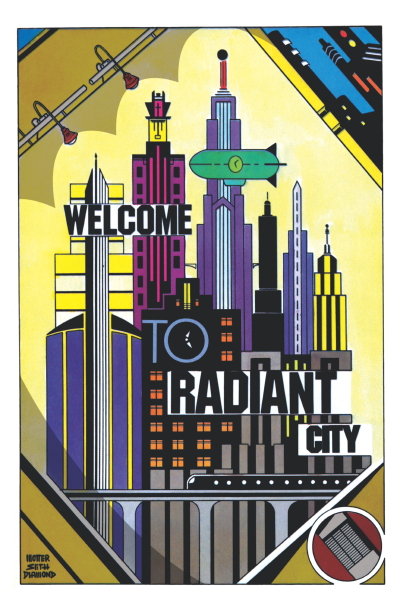
DH: The character Mister X is a cold, strange drug-addict who is always disappearing and causing destruction. He may even be a violent psychopath. Yet, people, especially women, are struck by his personality. Can you comment on this paradox, and perhaps explain why you chose an anti-hero (or Byronic hero) as the protagonist for the series?
DM: Originally, I thought of him as The Spirit (Eisner) But aside from being unoriginal, it made him a crime fighter, and again, when he changed archetypes, he became more like Doctors Jekyll and Frankenstein to me. He was tortured by his own work, which he was somehow doomed to put right. Why the women are attracted to him -- mostly to balance the story, but also as an asexual character (a side affect of the drugs), perhaps on some deep, subconscious level perhaps, they believe they can somehow save him sexually. That's not misogynistic, is it?
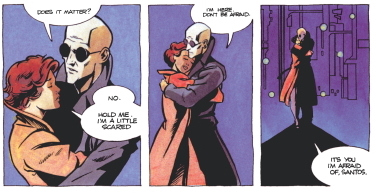
DH: Some have said that Mister X is influenced by Art Deco, German Expressionism, and Film Noir, is this true? What other influences have shaped the book?
DM: This is very true. I had been studying those genres for some time and wanted to somehow bring them to bear on my new work. My previous big epic, The Sacred & The Profane, was influenced by the Symbolists, the Pre-Raphaelites. As an art history student in college, I was always very ambitious about introducing comics to aesthetics other than other comics. In Mister X, I also tried to incorporate Russian Constructivism, the Bauhaus, modern de-constructivist architecture, mid-20th industrial design (Loewy, Bel Geddes, Dreyfuss). And, even the covers of 30's/40s science/mechanics pulp magazines. Of course, the music and attendant graphics of the era it was conceived in (Ultravox, Eurythmics, Roxy Music, Joy Division, Soft Cell, etc.) [as well].

DH: There seems to be a cautionary tale about technology and trying to master your environment in Mister X, is this intentional?
DM: Not at first. That was more a theme that emerged as time went on. It wasn't supposed to have any lesson. It was supposed to be more like a noir film where justice is cruel and chaotic, and the only struggles are the degrees of desperation and occasional redemption.
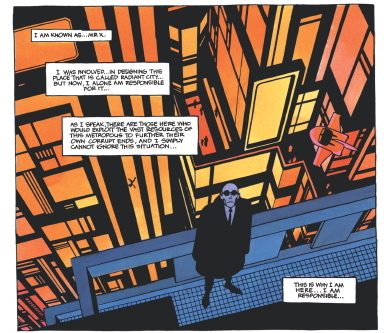
DH: What brought Jamie and Gilbert Hernandez to the start of Mister X?
DM: It was a business decision. My collaborator (Paul Rivoche) and I had reached an artistic/procedural impasse after working on the development phase for over a year (while being paid for it by our publisher.) Vortex Comics finally could no longer afford to NOT have a book out, and studio mate Ken Steacy suggested and facilitated the employment of the Los Bros. by Vortex. Seemed like a super solution. I still handled art direction, design, and editorial direction. Paul colored and lettered the book and painted the covers. Gilbert would script from my treatment with Mario's help, and Jaime would draw the thing. Everyone was happy. Especially the publisher.
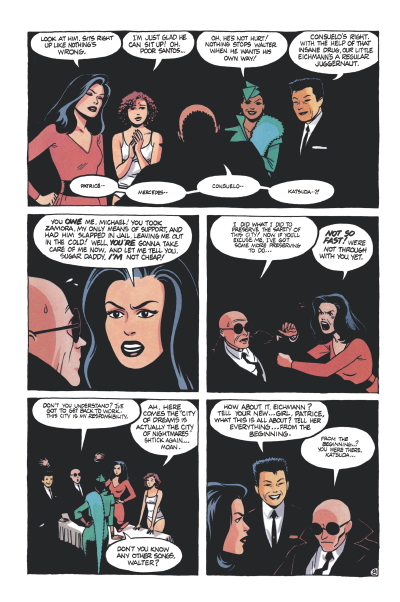
DH: There is a place called “The Ninth Academy” in Mister X where incredible intelligent, yet insane people are housed. Do you think that creative genius and mental instability go hand-in-hand?
DM: Well . . . creativity and eccentricity certainly do. And, so many creative genius suffer from addiction or depression or all manner of mental 'disorders.' Rosetti, Beethoven,Van Gogh. Hemmingway. Poe. Cobain. Spalding Gray, etc. I just institutionalized it. I rather like the Academy. It is so contradictory in nature, yet such a neat symbiosis.
DH: In the new series, Mister X: Condemned, which you write, draw, color, ink, and letter, there is a huge shift beginning that directly affects the architecture of the city. What do readers need to know going into the new story?
DM: Nothing at all. I am trying to write this as if the reader had never heard of, nor read, Mister X. This is a re-imaging, as the movie biz likes to call such things. I'd like new readers to become curious about the publishing history and pick up the Archives, but it really is meant to be a 'reboot of the franchise', as they say. More importantly, over the years, I think I've become better at doing this. And, with Terminal City and Electropolis, I have been able refine the nature of my vision of a retro-future.
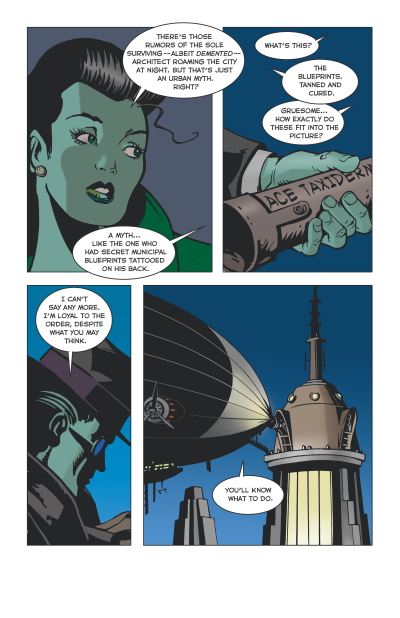
DH: When Mister X first appeared in the 1980’s, it was hailed as a breakthrough for graphic novels in terms of content and style. Who do you think is doing extraordinary work today?
DM: The industry has changed so much. We were part of a vanguard (that included Heavy Metal, Byron Preiss, Dark Knight, American Flagg!, Watchmen, Violent Cases, etc.) that introduced higher production and design values to the medium at the time. So, the work that strikes me somehow spins from that, whether it's Alex Ross, Darwyn Cooke, Chip Kidd, Michael Chabon, or Chris Ware. In terms of 2009, some of the books on my mandatory list are Hellboy, The Goon, 100 Bullets. But, there are new things all the time, especially with Internet comics blossoming.
DH: Do you have any advice for aspiring creators?
DM: It's corny -- but originality is all. Even if dealing with traditional concepts or derivative elements, make the combination original. And, make certain you enjoy the process. The minute it becomes a chore, there's no more point.
DH: Even though your work tends to stay away from the traditional superhero genre, if you could have a super power, what would it be?
DM: I always liked Matter Eater Lad, but I think maybe the Flash's powers would be more useful.
Check out the new series, Mister X: Condemned, on stands now!